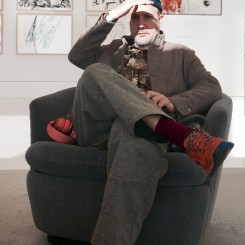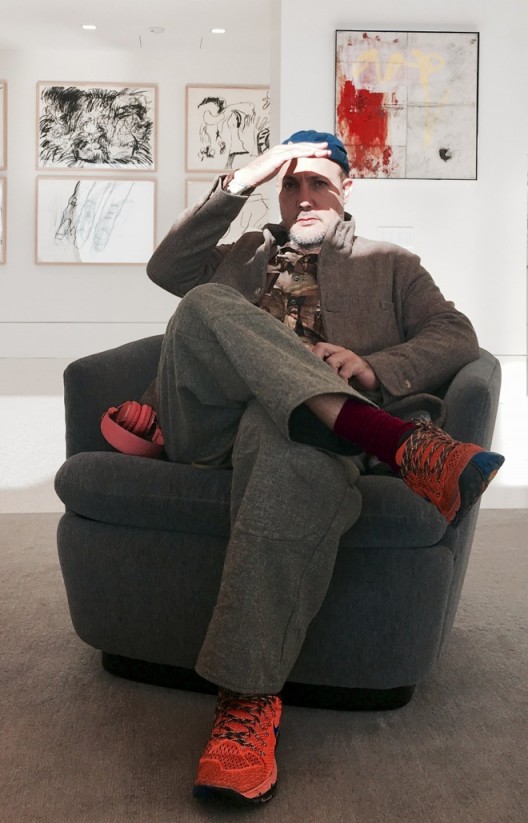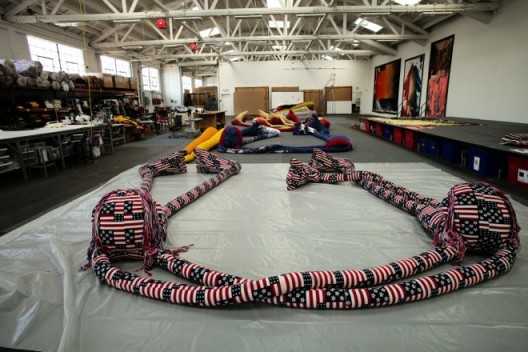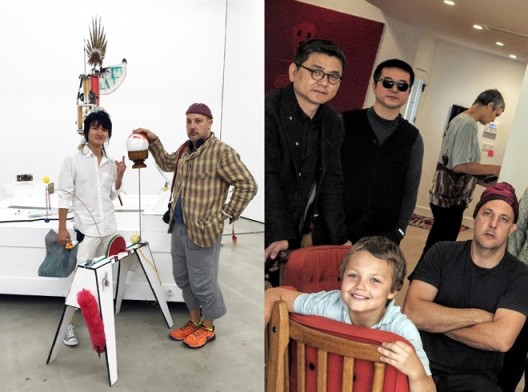—Interview with Stefan Simchowitz
Stefan Simchowitz was born into a wealthy Jewish family in Johannesburg, South Africa, and brought up on three continents—Africa, Europe, and North America. At the age of 11 while attending a Jewish day school in Johannesburg, Simchowitz, being younger and physically smaller than other boys, was bullied and assaulted by his classmates who broke his leg in four places. They stole his lunch every day. Determined to have his revenge, Simchowitz removed the wrappers from store-bought pork pies and put them in his lunch box. At the end of the school year, he left the label on for the boys to realize that they had done the unthinkable: eating the most unkosher meat there is (for the record, Simchowitz himself doesn’t mind eating pork).
For a few years after his graduation from Stanford with a degree in economics, Simchowitz treaded water in Hollywood, producing several films including Darren Aronofsky’s Requiem For A Dream (2000). He then ventured into the business of collecting and dealing art, financing artists, and sponsoring institutions. His ambition eventually gave birth to Simcor LLC, a company that has ten employees on the payroll and which generated nearly 150 million dollars in sales in 2016.
Today, Simchowitz, who considers himself an American rather than a South African, lives in Los Angeles with his wife and business partner Rosi Riedl and their son Morris. His controversial business model, obstinate personality, omnipresence on social media, and big mouth have consistently earned him a spot at the center of heated and polarized debates about his policy of aggressively stockpiling emerging artists’ work so as to compete with galleries and dealers for their market share. This isn’t unusual for collectors. The only things separating Simchowitz from others are his voluntary transparency and his stubborn will to disrupt the system.
Danielle Shang: How does having grown up in South Africa influence your taste in art?
Stefan Simchowitz: South Africa was not under the influence of Warhol or Lichtenstein’s pop art, because mass media were suppressed in the ’70s and ’80s, and nobody cared about celebrities. The lens through which I look at art history is different. I’m not fixated with the pre-fixed menu of Warhol, Ruscha, Kapoor, Condo…which is like a stock portfolio. Coming from a different geographical environment gives me an opportunity to observe things from a more diverse perspective.
The problem with New York-centric Western art is that the lens focuses only on this geographical standpoint and the timeline of the postwar period. But if we look beyond that, Warhol might not be so important; instead, Goya becomes more important, or Chinese ink painting becomes more important. We need a broader platform on which things can be historically equalized.
DS: Why are you focusing on only young and emerging artists?
SS: Because I believe in it. I want to be involved with the culture of my time. I don’t want to be a real estate broker who represents and resells something that’s been there for a long time. And it’s more exciting to see a piece of land that has not been explored; five years ago, I thought Africa was interesting, so I googled contemporary art in every country in Africa.
DS: Why Africa?
SS: Because I think we need a new voice; and because I hypothesize that Africa, by the year 2050, will be the biggest economy in the world. I saw an image by Ibrahim Mahama on Instagram and contacted him. I saw images of Serge Attukwei Clottey in a performance in Ghana. I called him up.
DS: How many artists are you currently backing?
SS: I manage five artists fully. And I support several other artists directly and indirectly.
DS: How did you discover Oscar Murillo, Parker Ito, and Sterling Ruby?
SS: I saw Murillo in a group show at Nicodim Gallery, I bought all of his works. I found Parker Ito on a website called Nasty Nets prior to Facebook. I contacted him. He had no money. He wore a hazard mask and painted oil wrecks. He drove to my house and pulled out paintings from the trunk of his car. I paid him $10,000 for everything. He was ecstatic and introduced to me his friends, including Artie Vierkant. I was at Metro Pictures in 2006 and bought a few pieces that I liked. I asked who the artist was, and they told me it was Sterling Ruby.
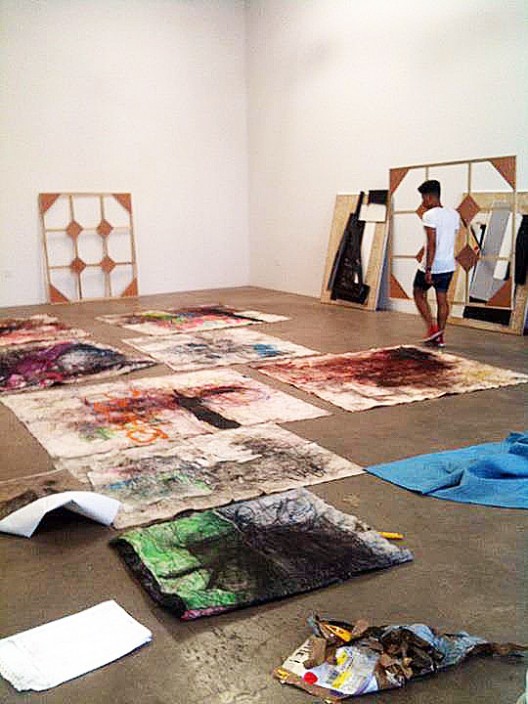
Oscar Murillo installing works at Nicodim Gallery, 2011 (courtesy of the artist and Nicodim Gallery)
DS: Do you credit yourself for discovering them or putting them on the map?
SS: The action of discovery of an artist belongs to everyone. It is not singular. I’m not Lewis & Clark. But it is not just the action of discovery that matters, also how to actualize that discovery to provide resources to that artist so that they can fulfill their potential. I look for talent, not the final product. I enter when they are at the early stage of their career.
DS: But then you and Mahama took turns suing each other.
SS: That’s fantastic! I sued him and made him even more famous.
DS: What happened with Oscar Murillo?
SS: His gallery is nervous because he sold me too much material early on, so they constructed a narrative against me.
DS: Are you worried about your relationship with the current artists whom you work with, for example Petra Cortright or Kour Pour?
SS: Petra and I have a very transparent and trusting relationship. It’s been successful for her. You know Petra dressed like me on Halloween. People warned her not to be associated with me. But Petra says, “Everything this guy says, he has delivered.” Many artists have surrounded themselves with people who are competitive, who want to represent the artists themselves, therefore they are quick to demonize me in order to fight for a plate at the dinner party.
DS: On more than one occasion, you have lamented that artists are disloyal, greedy, selfish, narrow-minded…
SS: I say it because we have an illusion that artists are holding a higher moral standard. Ai Weiwei trades on that currency because he understands the mythology of artists in society, and how easy it is to manipulate it. The West, which loves the mythology of morality, has provided a perfect structure for him to climb into and ascend the staircase. He is an important artist from the West’s perspective; that’s why to Westerners he is worth collecting. But is his role as a moral artist real? I’m not sure. Maybe he is just a Chinese guy who didn’t pay his taxes. A lot of artists, curators and art world people would happily step into this position if it were provided to them.
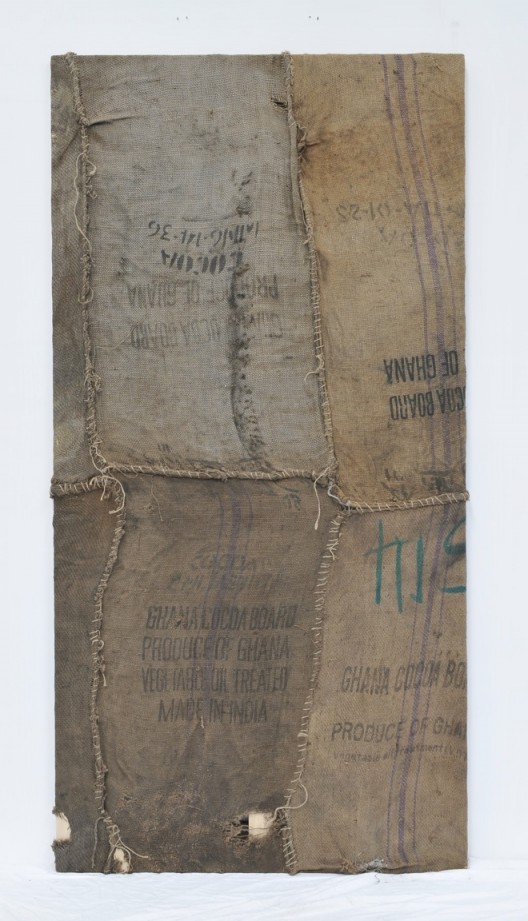
Ibrahim Mahama, “Untitled”, 2013-14, jute coal sacks, 96 x 48 in (courtesy of the artist & Stefan Simchowitz)
DS: How did you become blacklisted by Blum & Poe?
SS: I like Darren Bader’s work, which is not easy to sell, but the gallery refused to sell me his works. So I sent over a young female consultant, and the gallery offered her everything. I walked into Jeff Poe’s office and told him the truth. Jeff got upset.
DS: Why did you have to tell Jeff? Is this the pork pie revenge?
SS: I like to challenge them, just like I challenged the guy who broke my leg: because it was stupid. Why should people play games? I then realized that these businesses tried to create an illusion. Galleries would tell me that there is a line of museums waiting, or it’s sold out. Then I send someone else in and buy the whole show.
DS: Do you circumvent galleries to approach their artists?
SS: 100%! I love doing it. I have no license not to. But I won’t if the gallery is good, like Nicodim Gallery, who introduces to me many young artists; some are Chinese. Mihai (Nicodim) is a solid guy—he is sensible, doesn’t play games. Also some other galleries like François Ghebaly, Redling Fine Art, China Art Object, Roberts & Tilton, Hauser & Wirth, Gagosian Gallery, etc.—I don’t bypass them, because I enjoy working with them.
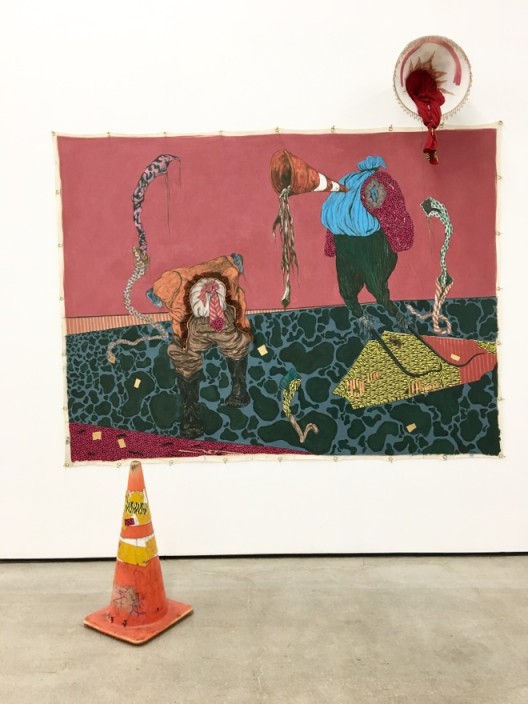
Simphiwe Ndzube, “Torchbearers”, 2016, acrylic, garment, & mixed media, canvas size: 72 x 96 in (courtesy of the artist & Stefan Simchowitz)

Serge Attukwei Clottey and his work, “Friutfulness II”, 2016, plastics, wire & oil painting, 127 57 in (courtesy of the artist & Stefan Simchowitz)
DS: What is your relationship with the Depart Foundation? Do you rotate your artists there?
SS: No. I give them money; I give them suggestions and provide resources. Same with the Mistake Room. I introduced Cesar Garcia to Murillo and Korakrit Arunanondchai, who both ended up having solo shows there. I like to support small institutions because I believe in them, and they need support. I gave works to many institutions this year: MOCA, the Hammer, the Brooklyn Museum, etc. But I don’t claim to be a generous philanthropist and a moral human being. Because that’s bullshit! It’s convenient for the cultural industry to valorize collectors because the industry depends on them financially. People join the boards of the royal opera or ballet after living lives filled with savage business careers and ruthlessness. I call it the cultural dry clean of the world. This valorization and the mythological structure are there to create a false narrative.
DS: What is your personal economic view of the market?
SS: Economics is a social science. It’s the study of mankind and its relationship to money and exchange. I give you an example: why did Art 021 bring paintings by Adrien Brody to Shanghai? By the way, listen up, if you buy Brody’s paintings for social status, you are making bad decisions. Watch his movies, but don’t buy his art. Don’t think of him as a handbag by Louis Vuitton. Buying his painting is a social behavior; it has nothing to do with art. Before you analyze art, like finding a diamond in the mud, you have to cut away all the disgusting feces of emotion, greed, morality, and ego. At the end you have this shiny rock. Put all the bullshit aside, Ai Weiwei’s sunflower seeds and the marble doors are beautiful objects. At the core, there is the greatness. But the greatness is the greatness of the West that mythologizes him for his “moral role.” He is a good artist without the baggage of morality and Western art history, because he understands the object and the decorative nature of art.
DS: You love the topic of morality!
SS: I’m fixated with two things. One is morality, which is a behavioral subject that we use to relate to art for economic means and for status; on the other is the current distribution system of art. I want to break the rhythm. I want to turn the aircraft carrier around. And I’m turning it, single-handedly, I may add. [A big grin on his face] Actually, artists should be the ones being fearless, but they are too encumbered with the system and too scared to speak their minds, because they are afraid to alienate curators and their dealers.
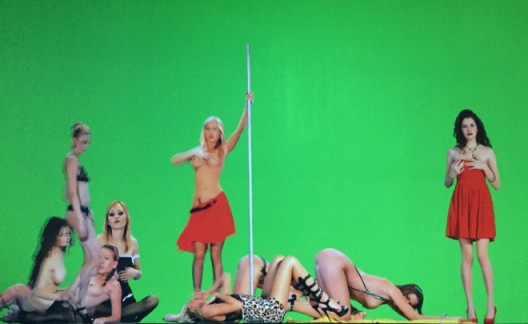
Petra Cortright, (still image from) NIKI, LUCY, LOLA, VIOLA, 2015 (courtesy of the artist & Stefan Simchowitz)
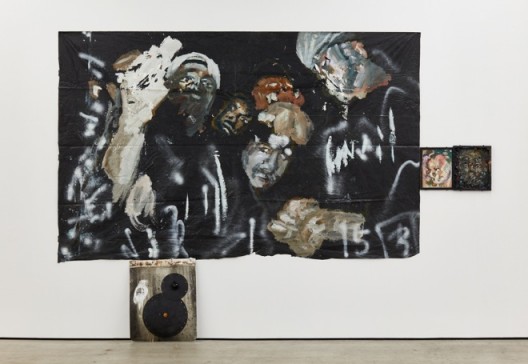
Zhou Yilun, “Respect”, 2015, mixed media installation, 113 x 174 in (courtesy of the artist & Stefan Simchowitz)
DS: How do you want art to be distributed?
SS: The postwar period has been defined in a linear hierarchy; America dominates the postwar narrative, and New York is the center. But now other economies are growing: China, Africa, India…Then comes the internet: people connect through it and distribute images, so the distribution of art changes from a linear model to more diverse modes. The distribution of art becomes inseparable from the production and exhibition of art. If you talk about art, you can’t avoid talking about artist distribution. A transformation occurs when the collector becomes the artist—not just in the Duchampian sense that a collector becomes a speculator transmuting the art from its raw state to a refined state. And we end up in a system where the linear hierarchy is replaced by a nonlinear hierarchy that sporadically changes according to the circumstances, which themselves are random and non-linear. The complete redefinition of the postwar art system was laid out by Duchamp with a urinal in a museum. We have to revisit this concept, because this is the radical shift in the art industry.
DS: How do you see yourself in this radical shift?
SS: I see myself as the architect of this order, reconstructing not only a new business model but also reclassifying what it is to produce and distribute art in the 21st century. I think people overlook my intellectual strategy in this mission. I have the intention to create an ideological structure for the reformation of art and its processes of integration into the global system.
DS: You made it into the [Art Review magazine] “Power100” list last year.
SS: Well, they took me off this year because they wanted to hold on to the same linear thing. It’s an example of them not accepting the change. So I’m putting together my own list called “Simco’s 100 List”. It’s coming out on December 31st.
DS: You use the terms “production” and “distribution” a lot. These are terms used in the film industry. Do you see parallels between the art business and the film business?
SS: Absolutely. They both are about generating content. In the post-internet and social media era, the physical object becomes documented and itemized as content online first, and then commoditized. However, during the transformation of art into cyber content, the physical object still exists in its original form.
DS: What can we learn from the film world?
SS: The film world does a good job building a distribution system. It’s able to localize and differentiate those distribution systems for the same product. For example, they market Star Wars in China differently from in Africa.
At the end of the day, I believe in creating a formal, established, controlled market by building a proper supply chain and not having the power resting in galleries who are essentially retailers. I see myself as a wholesale financier. Right now, there’s not a proper supply chain; art is not evenly distributed.

Simchowitz with artist Jeff Koons (left) and actor Orlando Bloom (right) (courtesy of Stefan Simchowitz)
DS: I know you love social media for disseminating information and images. What content do you decide to put on which platform?
SS: I just started to use WeChat. I haven’t figured it out yet. Instagram is about pictures that I like and artists I want to show. Facebook is more complicated. It’s my diary.
DS: Does your Facebook page reflect your view of the world?
SS: Absolutely. Politically and socially I’m very liberal. Economically, maybe not so much. [Another big grin on his face]
DS: You once said “My ideal operation will more closely resemble the CIA.” Can you elaborate on this analogy?
SS: I want to build an engine to finance, wholesale, produce, distribute, and organize artists. The CIA is invisible; you don’t know what they are doing and how they are doing it. It’s not particularly a moral organization, but they are very good at making you hear things from different corners: when one person is singing, you hear a choir. The culture industry needs an underlying intelligence structure to support art’s distribution.
DS: So the CIM (International Creative Management, a talent and literary agency) project is your way of being the CIA?
SS: Absolutely. Instead of spending millions of dollars to fund a museum, I decorate an institution with 400 works by 90 artists from my collection. I call it Museum 2.0. 400 people come in and out on any given day. Meetings with Hollywood shakers and makers take place there. From Samuel Jackson to Ellen DeGeneres, Katie Holmes, and Emmanuel Lubezki—the best cinematographer in the world, who was responsible for The Revenant. They all engage with the art.
DS: What do you think about the market and artists in China?
SS: I don’t know enough about China. But I have collected a few, such as Liao Guohe and Zhou Yilun. But in general, Chinese artists’ prices are too high, and are not accessible for the Western audience.
DS: You have met Wang Bing, Tian Jun and Qiao Zhibing. What do you think of them?
SS: I like them. They are smart and ambitious. I’d love to visit them in China. China is the future. I want to have a Chinese audience. But I also want to make my world the center for anyone to visit. I want to be the rock of the foundation, the visiting point, the point of access. My place is open to everyone.
Los Angeles, December, 2016

